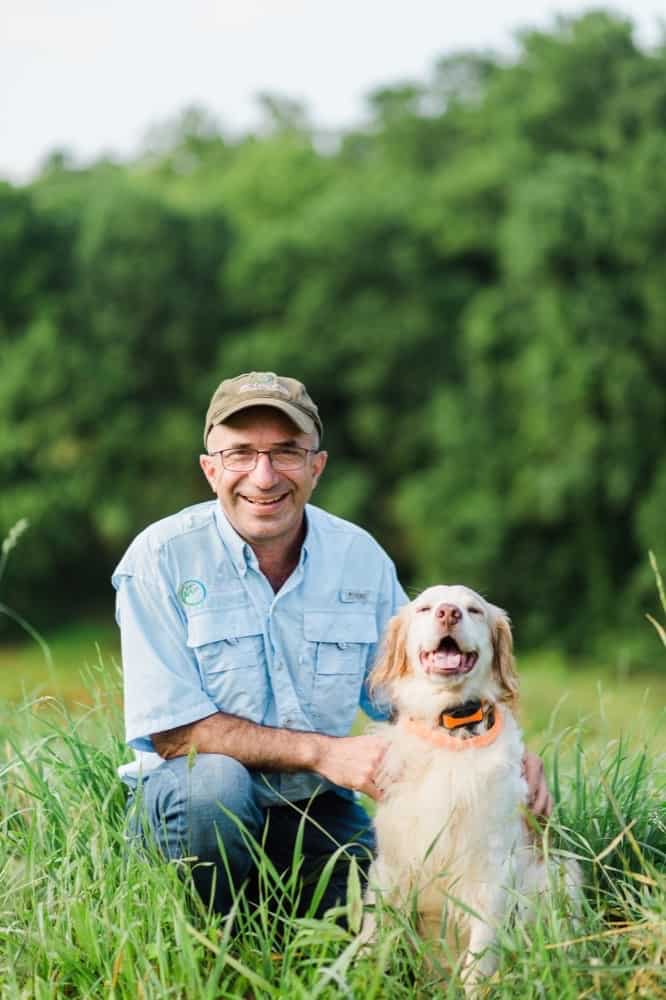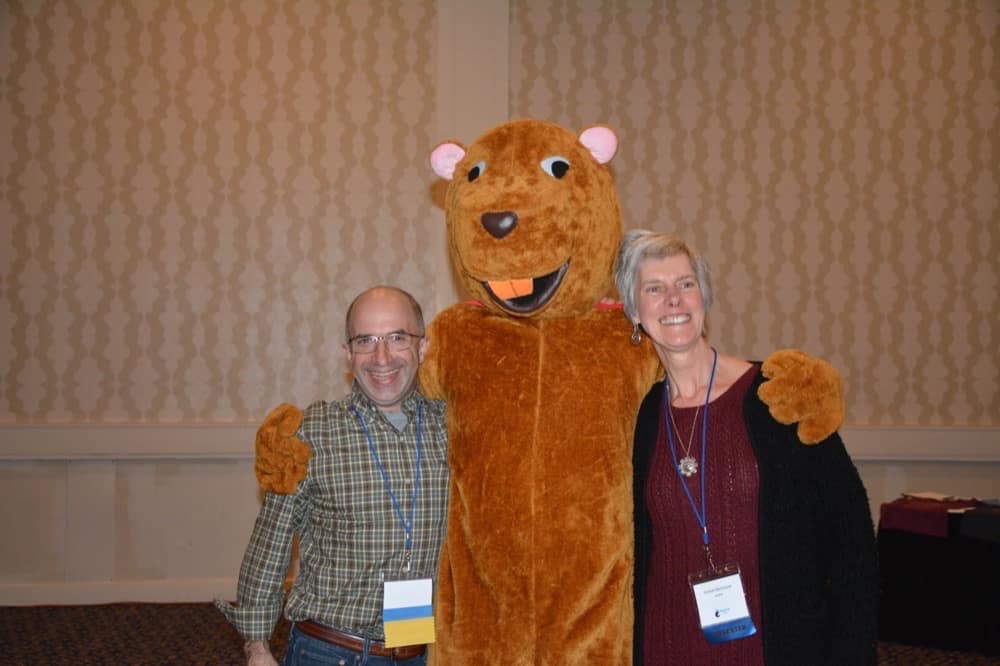There’s an outstanding article in the Chesapeake magazine this month. Exactly one year after the east coast beaver conference things are finally catching on. It’s a nice feature for our newest convert Scott McGill who definitely believes. Too bad they got Mike Callahan’s name wrong!
Beaver Believers
Although we don’t see Mr. or Mrs. Beaver this day (beavers are nocturnal by nature), their infrastructure is evident, and their neighbors are active. During our trek, we hear small birds chatter, startle several great blue herons and flush a flock of wood ducks. Hawks soar above us. Reaching deeper water, we watch small circles dimple the surface where brown trout are rising to feed on insects. Trout are one of several fish species—including dace, chubs and sculpins—that consume bugs and aquatic plants living in the impoundment’s cool, clear , nutrient-rich water.
, nutrient-rich water.
McGill points out the resident beaver colony’s nearly six-foot-tall dam and the rambling, domed main lodge they’re constantly remodeling with sticks and mud. I stumble, literally, on one of their transportation networks, accidentally plunging one leg into a deep, beaver-dug channel the animals use to reach distant food sources.
In the mid-1990s, as a volunteer with Trout Unlimited, McGill worked on a stream improvement project along this very stretch of Long Green Creek, a Gunpowder River tributary that meanders through the forests and fields of Baltimore County. The landowners wanted to improve habitat for trout, a coldwater-loving species, in the stream that flowed through their pasture. They agreed to fence off a portion of the creek and have trees planted to shade the stream.
Nothing starts out better than a good beaver story. I’m sitting down and pouring another cup of coffee. Aren’t you?
By the time the landowners summoned McGill back to the site 12 years later to address a beaver-landowner conflict (the former’s dam was flooding the latter’s access to a back cornfield), he had had a “beaver epiphany.” Instead of trapping the relentless rodents, as the landowners were doing reluctantly, why not incorporate beavers’ natural construction inclinations into Ecotone’s stream restoration projects? In other words, allow the beavers to build upon and maintain—at minimal cost—work the company had begun.
Some environmental professionals had been preaching the practice in the West for years. McGill says he scoffed at their “nutty” notion initially, then became curious. He attended beaver-focused stream restoration workshops by experts such as Utah State University fluvial scientist Joe Wheaton and ecosystems analyst Michael Pollack, co-author of the Beaver Restoration Guidebook.
He became an eager reader of beaver books. From Frances Backhouse’s pithily titled Once They Were Hats, he learned that before beavers were nearly wiped from the land in the name of fashion more than a century ago, they performed instinctively the work that companies like his do when they “repair” today’s compromised natural landscapes. Now that the animals are returning in greater numbers, McGill figured, why not work with them?
Why not indeed? A question we often ask ourselves here at beaver central.
Thanks to the beavers, Ecotone’s 10-acre, seasonal wetland has become a larger, deep-water mosaic of wetlands that supports a diverse array of fauna and flora, and also serves as a natural filtration system for Long Green Creek, whose waters ultimately reach the Chesapeake Bay. “This is like a huge multimillion-dollar storm management pond—for free,” McGill says of the waterscape around us.
Runoff sediment tends to settle here harmlessly. Dissolved nutrients such as nitrogen are taken up by plant roots and bottom soils. When storm waters rage, the beaver pond holds and then slowly releases them, diminishing downstream flooding, damage to infrastructure and stream bank erosion.
As for the landowners’ drowned farm lane, Ecotone installed flow devices, manmade beaver-flummoxing gadgets that permit water to flow freely through beaver dams and reduce the surface elevation of beaver ponds. Two flow devices were all it took to allow the beavers and the farmer to coexist, albeit tenuously.
The right flow device in the right place makes all the difference, Just ask Martinez.
Beaver advocates—they are many and quite passionate—maintain that beavers are, and always have been, far more valuable alive than they ever were as the stuff of hats, fragrances or Roaring Twenties outerwear. Beaver, both Castor canadensis and Eurasian Castor fiber, are widely regarded as a keystone species, animals whose preternatural ability to alter and enhance their environment greatly exceeds their numbers.
McGill and others are trying to spread the beaver gospel. Last March, just before the coronavirus shut down such gatherings, Ecotone co-hosted BeaverCON, the East Coast’s first conference for beaver practitioners, researchers and journalists. It’s where I was introduced to McGill. Part business convention, part fan fest, the three-day event attracted several hundred attendees from the United States, and a handful from Canada and Europe.
I can’t believe this importance conference is finally getting credit. Unfortunately the reporter forgot Mike Callahan’s name and calls him “Bill”. That’s gratitude for you, He made the thing happen in the first place!
 The gathering was held in a Marriott hotel just north of Baltimore. But it wasn’t your standard business conference. Most attendees were dressed for a day in the field (flannel shirts, fleece vests, the occasional Maryland DNR uniform) rather than a conference hall. An Ecotone employee in a caped beaver costume popped in and out of the proceedings. And as conference-goers filed into the Valley Ballroom the first morning, they were greeted by an editorial tableau: a beaver diorama, the kind you’d see in a nature center. But this taxidermy Castor, permanently poised to chomp on a sapling, seemed to be glaring at the object next to it on a display table—a vintage felted-beaver top hat.
The gathering was held in a Marriott hotel just north of Baltimore. But it wasn’t your standard business conference. Most attendees were dressed for a day in the field (flannel shirts, fleece vests, the occasional Maryland DNR uniform) rather than a conference hall. An Ecotone employee in a caped beaver costume popped in and out of the proceedings. And as conference-goers filed into the Valley Ballroom the first morning, they were greeted by an editorial tableau: a beaver diorama, the kind you’d see in a nature center. But this taxidermy Castor, permanently poised to chomp on a sapling, seemed to be glaring at the object next to it on a display table—a vintage felted-beaver top hat.
Attendees embraced varied stages of beaver belief, from mildly curious to devoted apostle. They were welcomed by co-hosts Bill Callahan, a beaver practitioner, educator and founder of a management best-practices organization called the Beaver Institute, and by the ebullient McGill, who opened the event with a hearty, “Goooood morning, Beaver—CON!” In lectures over the next few days, a who’s who of beaver cognoscenti advanced the argument that an environment imperiled by climate change and human habitation urgently needs more beaver-enhanced Narnias. Castor’s habits can be bothersome, believers concede, but they are eminently manageable and well worth the effort.
Isn’t that always the way. You spend months planning and days of your life making it happen and they forget your name before it’s over. Been there. Done that.
Enter the Beaver Deceiver, the invention of New England biologist and entrepreneur Skip Lisle. When introduced at BeaverCON, Lisle received celebrity-status applause when he mentioned his popular creation. If there’s a Thomas Edison of beaver exclusion technology, it’s probably Lisle, who didn’t so much conceive of beaver barriers as build a better, trademarked one. Deceivers and other flow devices of differing design—Castor Masters, beaver bafflers, pond levelers, culvert fences and diversion dams—are engineered to outwit beaver, a task more complicated than you
might think.
HA! Well at least the reporter remembered Skip’s name right.
 Back at Narnia, McGill has another, nearby, restoration project he wants to show me. It’s a far different landscape, a scruffy, open field bisected by a meandering stream. Ecotone began planting vegetation along Bear Cabin Branch in Harford County in 2018. Several months ago, three beaver families moved in. Since McGill lasted visited here five days ago, one of their rudimentary dams has raised the water level a full foot in a portion of the creek. That will allow the flood plain to widen, he says, mitigating downstream flooding and trapping more sediment.
Back at Narnia, McGill has another, nearby, restoration project he wants to show me. It’s a far different landscape, a scruffy, open field bisected by a meandering stream. Ecotone began planting vegetation along Bear Cabin Branch in Harford County in 2018. Several months ago, three beaver families moved in. Since McGill lasted visited here five days ago, one of their rudimentary dams has raised the water level a full foot in a portion of the creek. That will allow the flood plain to widen, he says, mitigating downstream flooding and trapping more sediment.
“I can’t get a permit to do this,” McGill says of the impoundment. “But a beaver can do the work for free, and the water quality benefits are much better.” It’s a natural partnership, he says, “We’re restoring the Bay one beaver at a time.”
Isn’t that wonderful? Go read the whole delightful thing and remember Mike Callahan’s name when you do. Covid ruined a lot of things in 2020 but it decided to let the first days of March see its first beaver conference on the east coast a success.
That’s plenty lucky.






































